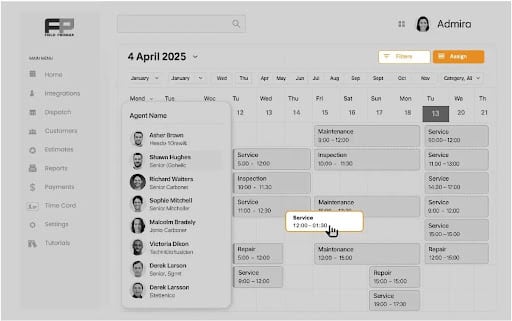Table of Contents
Running a growing field service business feels like trying to juggle while someone keeps adding more balls. One job runs late, another customer calls with an emergency, and suddenly your carefully planned day looks like a circus. This is the point where scheduling software can help.
The right software keeps your team on the right track, reduces the number of wasted trips, and makes your customers feel like you’re three steps ahead instead of three steps behind. But with so many options out there, how do you know which scheduling software works for growing teams in 2025?
Let’s break it down.
Why Scheduling Software Is No Longer Optional?
Once upon a time, whiteboards and sticky notes were sufficient to handle tasks. Those days are gone. Growing teams in HVAC, plumbing, or electrical work require systems that do more than simply place jobs on the calendar.
Here’s why:
- Speed matters. Customers are expecting updates the same day and not a callback on the next day.
- Teams are mobile. Teams are always used to mobile. Your team spends more time in the field or vans than at desks.
- Data drives growth. If you’re not able to see where your money and time are going, then you’re making assumptions instead of growing.
In short, scheduling software is no longer “nice to have.” It’s the backbone of efficiency for field service businesses scaling up in 2025.

Features That Growing Teams Need
Not all scheduling software is made equal. Some are pretty but fall apart when your team expands beyond a handful of techs. Some are loaded with features that you won’t utilize. It is important to concentrate on features that make life easier for both managers and technicians.
Here are the essentials:
- Real-time updates: When a job changes, everyone should know instantly, not after six missed calls.
- Drag and drop scheduling: No one wants to battle a complicated interface to shift the job from Tuesday to Thursday.
- Mobile access: Your team lives on their phones and tablets. A scheduling tool that only works on a desktop is as useful as a wrench without a handle.
- Route optimization: Less time in traffic means more tasks completed within a day, and less money spent on gas.
- Customer communication: Automated text messages and emails that confirm appointment times ensure that customers are informed without draining office staff.
The most effective software for 2025 will be able to cover these areas and be user-friendly. But the fact is, if your technicians hate the tool, they will not use it, no matter how much you spent on it.
Common Mistakes Teams Make When Choosing Software
The process of selecting a scheduling software can be like buying a brand-new vehicle. It’s all shiny and new at first; however, a few months later, you discover the only thing you like is the cupholder.
Teams that are growing often make these mistakes:
- Falling for bells and whistles: Fancy dashboards and charts appear stunning, but if they can not help you with your scheduling issues, they are just a decorative touch.
- Ignoring the mobile experience: Your field crew is not sitting at desks. If the mobile app is clunky or slow, adoption will be a nightmare.
- Overlooking integration: Scheduling should not work in isolation. If it doesn’t integrate with your accounting system or the work orders system, you’ll spend time juggling data between different tools.
- Not testing with the team: Managers often pick software without letting technicians try it. This results in frustration, confusion, and half of the team returning to their old practices.
- Underestimating growth: A tool that is designed for five users might fail for twenty. Always consider how big a team you would like to have, not just the size you are now.
Avoiding these errors is a way to save time, money, and a lot of stress. The right software should make you appear as if it were created for your team, and not imposed upon it.
Top Contenders in 2025
The service scheduling market is crowded, and nearly every software claims to be “the best.” Growing teams in 2025 should focus on platforms that are proven, reliable, and built for field service work rather than generic business scheduling.
Some of the names you will often hear include:
1. Field Promax: A comprehensive option designed to combine scheduling, dispatching, and reporting with a straightforward setup that even less tech-savvy teams can adopt quickly.
2. Jobber: Popular among small to mid-sized businesses, known for its clean interface and ease of use.
3. ServiceTitan: A heavyweight choice with powerful features, often better suited for larger companies with bigger budgets.
4. Housecall Pro: A favorite for home service providers, offering strong mobile tools and customer communication features.
Each of these platforms has strengths, but the real difference comes down to how well they fit into your daily workflow. Scheduling software should make your life simpler, not add another layer of complexity.
How to Pick the Right One for Your Team
Finding the best scheduling software is not about choosing the most expensive option or the one with the longest feature list. It is about choosing the tool that fits your team’s habits, your customers’ expectations, and your business goals.
Here are some smart ways to make the choice:
- Start with your workflow: List the scheduling pain points your team faces every week. If the software cannot fix those, it is not the right fit.
- Test with your technicians: A short demo is not enough. Let your field team try the tool for real jobs and gather their feedback.
- Check integrations: Make sure it connects with the tools you already rely on, like accounting, CRM, or inventory management.
- Look at scalability: Does the software handle more users, more jobs, and more data as your business grows?
- Evaluate support: Even the best tool will hit snags. Strong customer service and onboarding support are critical.
When you choose software this way, you are less likely to waste money on something that looks good in theory but fails in the field.
Making the Final Choice
Picking scheduling software is less about who has the flashiest features and more about what works in the field. That’s why looking at real user experiences is often more useful than reading marketing pages.
Here’s what service teams shared about using Field Promax:
- “It is super easy to integrate. My techs love it. My business has become super efficient.” (Reddit reviewer)
- “Overall, this is a very solid product and we have been more than happy with our experience.” (Capterra user)
- “We have been using Field Promax for a few years now. The features are easy to use, and customer service is great.” (QuickBooks reviewer)
Why Field Promax When It Comes to Scheduling Software
For growing teams, the appeal of Field Promax comes down to practicality:
- Simple scheduling that does not get in the way of work.
- Mobile access so technicians can see everything on the go.
- Integration with QuickBooks to avoid double entry.
- Clear reporting that shows where time and money are going.
- Support that listens when things get tricky.
Based on user feedback and hands-on adoption, Field Promax is not just another software option. It is one of the tools that helps growing service teams keep schedules under control while scaling smoothly into 2025.

Conclusion
In 2025, scheduling software will no longer be optional for growing service teams. It keeps jobs organized and improves customer experience.
We covered why scheduling matters, the features that count, the mistakes to avoid, and the top options available. The reliable choice is the one that fits your workflow and scales with your business. According to user perspectives, Field Promax stands out among them for its simplicity, mobile access, reporting tools, and dependable support.
